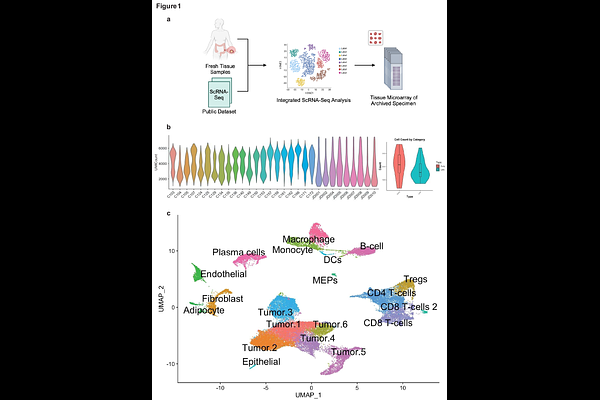Single-Cell RNA Sequencing and Inferred Protein Activity Analysis Reveal a Distinct Tumor Phenotype in Early-Onset Colorectal Cancer Patients

Single-Cell RNA Sequencing and Inferred Protein Activity Analysis Reveal a Distinct Tumor Phenotype in Early-Onset Colorectal Cancer Patients
Cohen, D. A.; Obradovic, A.; Jovanovic, L.; Mitani, Y.; Li, T.; Lee, S.; De, D.; Bethancourt, C.-N.; Shin, A.; Dunbar, K.; Cambuli, F.; Lengner, C.; Li, N.; Rogers, C.; Ho, J.; Jakubikova, V.; Blystone, E.; Pumpalova, Y.; Dionigi, B.; Vickovic, S.; Cheng, C.-W.; Gabre, J.
AbstractColorectal cancer (CRC) diagnosed before age 50 years (early-onset CRC, EO-CRC) is rising at an alarming rate, yet its molecular and microenvironmental drivers remain poorly understood. EO-CRC is highly heterogeneous, and while subtle differences from late-onset CRC (LO-CRC) have been reported, their full extent remains unresolved due to the limited scope of previous studies. Here, we integrate public data with in-house clinical samples profiled by single-cell RNA sequencing (scRNA-seq) and multiplex immunofluorescence (mIF) to compare EO-CRC and LO-CRC. Additionally, we employ gene regulatory network-based protein activity inference (VIPER), enabling a more precise characterization of key regulatory proteins driving tumor-stroma interactions. Our analysis reveals that EO-CRC and LO-CRC have a largely similar immune composition, challenging previous reports of an \"immune-cold\" phenotype in EO-CRC. However, we identify distinct stromal differences, including a significant enrichment of fibroblasts in EO-CRC. Notably, we define a previously unrecognized epithelial subpopulation in EO-CRC, marked by high expression of toll-like receptor 4 (TLR4) and C-C chemokine receptor type 5 (CCR5)--key mediators of inflammation-driven tumor progression and fibroblast recruitment. These findings suggest that EO-CRC may be driven by a tumor-intrinsic inflammatory phenotype with enhanced stromagenesis, providing new insights into potential mechanisms underlying its increasing incidence in young adults.